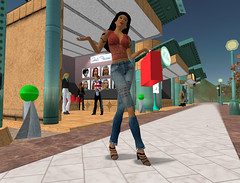Google Launches New Virtual Reality: Lively
Google has finally launched the long-awaited Lively virtual reality service.
Will it be a SecondLife killer, as some have suggested? So far, no, since it doesn’t have one huge planet or room for interacting with everyone as SecondLife does.
But this is the first baby-step Google has taken into VR, and we can expect them to evolve it further, particularly if the service proves popular. I haven’t tried it out just yet, but the feature descriptions include adding VR rooms to webpages, pulling photos and vids into the VR environments, and tying it closely to Google Talk – Google’s chat service. (more…)
Possible Related Posts
Posted by Chris of Silvery on 07/08/2008
Permalink | |  Print
| Trackback | Comments Off on Google Launches New Virtual Reality: Lively | Comments RSS
Print
| Trackback | Comments Off on Google Launches New Virtual Reality: Lively | Comments RSS
Filed under: Futurism, Google, technology Google, Lively, virtual-reality, VR
MicroSoft’s Ms. Dewey Linkbait: Avatars for Blogs & Other Uses
MicroSoft has launched an avatar-fronted search interface called
Ms. Dewey, in order to promote their MS Live search service. An avatar is a term coopted from virtual reality which is used to describe the graphic representation of a person within the VR environment.
The Ms. Dewey avatar is a clever piece of Flash engineering coupled up with various video files and the MS Live search engine. Ms. Dewey is played by an actress named Janina Gavankar, who apparently prerecorded a bunch of video snippets which are queued up contextually for various responses to search terms that are typed into the submission form field. After you submit a search keyword, she says (and sometimes does) something witty, then the MS Live search results scroll down in an AJAX menu beside her.
Try out these particularly funny search terms on Ms. Dewey:
| Congress gmail President Bush Dick Cheney weather forecasts Yo Mama |
Painting Lord of the Rings UFOs MySpace FireFox Halo 2 |
A “share this with a friend” link is included, making this qualify even more as some nice linkbait, as some online marketing folx refer to it. While quite a few folx have turned their noses up at Ms. Dewey as not being a serious search service contender, they’re perhaps missing the point that she’s pretty fun to interact with, and as a promotional effort goes, it’s probably pretty effective linkbait. Within just a short timeframe, many people will have emailed links to Ms. Dewey to their friends, getting a whole lot of people to use MicroSoft’s search engine who otherwise wouldn’t have tried it out.
I’d only say that the design group has dropped the ball a bit by not highlighting their MS Live brandname on the search results. (They also dropped the ball by advertising Ms. Dewey’s email address through the interface, ms-dewey@hotmail.com, because it’s inoperative, at least when I tested it. “Status: 5.0.0 – Remote SMTP server has rejected address”. They should have had someone responding to those notes, or they should’ve created an intelligent agent to respond to submissions to it.)
It’s maybe mentionable that Ask dropped the Jeeves butler mascot from the frontend of their search earlier this year, and here MicroSoft is adding a human mascot onto their search. Ask was never this attractive, though, and this ploy doesn’t seem in the least retro. Slick!
Interfaces like Ms. Dewey actually aren’t all that hard to do, and there’s one company that has made it really easy to incorporate interactive avatars similar to this within your blogs and other websites. Read on and I’ll describe how you can use avatars.
Possible Related Posts
Posted by Chris of Silvery on 10/30/2006
Permalink | |  Print
| Trackback | Comments Off on MicroSoft’s Ms. Dewey Linkbait: Avatars for Blogs & Other Uses | Comments RSS
Print
| Trackback | Comments Off on MicroSoft’s Ms. Dewey Linkbait: Avatars for Blogs & Other Uses | Comments RSS
Filed under: Link Building, Marketing, MSN Search avatars, linkbait, MS-Live, virtual-reality, VR
Brave New Future of SEO & SEM? Marketing thru Second Life
I came to hear about Second Life after reading about it in a blog by Greg Sterling, former editor and director of the Kelsey Group’s Interactive Local Media program. If you haven’t heard about it, read about it in this article. Second Life is basically a virtual reality (“VR”) platform (or, “world”, or “metaverse” if you will). People go in there, buy VR property or other objects, and interact with thousands of other participants.

“So what?” you might say. So, how does this differ from World of Warcraft, the Sims Online, or EverQuest?
First, there’s no goal to Second Life, per se — users just go into the thing, hang out, and interact with other users and the virtual environments. Second, users can own property in this world, and they can sell the property for real money in the real world! (Contrast with EverQuest, where they’ve actively worked to keep people from selling characters on eBay and such.) Finally, people have begun marketing through this new media — like gangbusters!

Copyright 2006, Linden Research, Inc. All Rights Reserved.
People like Anshe Chung are now making hundreds of thousands of dollars per year by designing and selling the SL virtual real estate. Others are offering services like architecture, event planning, selling artworks, scripting, and even financial or legal services. Some universities are now teaching within the space, too!
Possible Related Posts
Posted by Chris of Silvery on 10/24/2006
Permalink | |  Print
| Trackback | Comments Off on Brave New Future of SEO & SEM? Marketing thru Second Life | Comments RSS
Print
| Trackback | Comments Off on Brave New Future of SEO & SEM? Marketing thru Second Life | Comments RSS
Filed under: Futurism, Marketing, Search Engine Optimization, SEO online-marketing, Second-Life, SEM, SEO, virtual-reality, VR
Towards a New Cyberpunk Reality
I recently discovered something interesting about my company, Verizon.
Do you remember the old Oliver Stone tv mini-series from the early 90s called “Wild Palms”? It was about a dystopian future of America where a fascist political group has risen to power, headed up by a senator who founded a new philosophy called “Synthiotics” or “New Realism”, which apparently involves the next stage of human evolution and virtual reality (VR).
The Senator, named Anton Kreutzer, owns a company named Mimecom which has developed some sort of advanced VR technology and 3-d display technology which they are about to deploy out to households through a television company, called Channel 3, in a new drama series they’ve named “Church Windows”. They seemed to be using Church Windows as a platform for propagandizing Synthiotic tenets, as well. The Senator is seeking one last piece of technology from Japan, a “Go Chip”, which will essentially give him eternal life, and seal up his political power. The Go Chip is named after the game of Go, an ancient Chinese strategy game that has been used by artificial intelligence researchers as a test case for building systems which can learn and immitate human intelligence (though, they don’t really spell out that AI tie-in during the series).
The Wild Palms series was likely intended to be a very cutting-edge, conceptual story that was inspired in large part by the cyberpunk movement in science fiction. One of the prime “founders” of the cyberpunk movement, the author William Gibson, actually puts in a cameo appearance in the series, as well. Oliver Stone likely intended the story to use semiotic literary devices as well, since many of the plot items and names seemed to be intended to have multiple layers of meanings.
Here’s where fiction begins to turn into reality. MimEcom was the name of an actual ecommerce/hosting/technology firm that was later started up in San Francisco, and considered IPOing in 2000, though the dot-bombs happened, and it halted plans to go public.
Later, MimEcom changed their company name to “Totality”.
In about 2005, Totality was acquired by MCI. MCI was merged into Verizon later on in 2005. The Totality part was folded under the Verizon Business division of the company. (more…)
Possible Related Posts
Posted by Chris of Silvery on 07/14/2006
Permalink | |  Print
| Trackback | Comments Off on Towards a New Cyberpunk Reality | Comments RSS
Print
| Trackback | Comments Off on Towards a New Cyberpunk Reality | Comments RSS
Filed under: Futurism, General ai, artificial-intelligence, cyberpunk, future, Futurism, Go-Game, Google, MCI, Mimecom, science-fiction, search-engines, search-pets, semiotics, technology, Verizon, virtual-reality, Wild-Palms, William-Gibson



